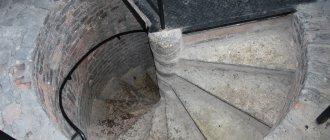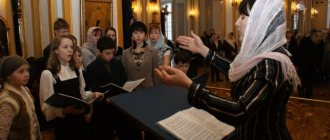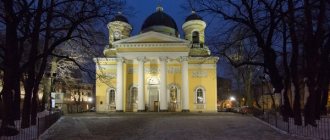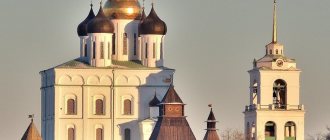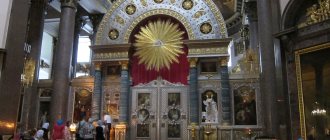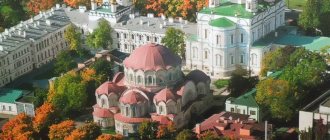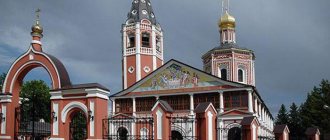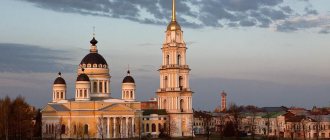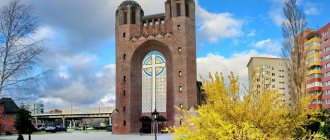St. Petersburg Trinity Cathedral is one of the most monumental churches in St. Petersburg. Its bright blue domes, decorated with gilded stars, are visible 20 km from Trinity Square, where it is located.
The full name of this solemn temple in the Empire style is the Cathedral of the Holy Life-Giving Trinity of the Life Guards of the Izmailovsky Regiment. In everyday life it is usually called Trinity, Trinity-Izmailovsky or simply Izmailovsky Cathedral. The temple was built as a regimental for one of the oldest Russian regiments, founded in 1730 by Empress Anna Ioannovna - Izmailovsky, which is why it received its name.
The cathedral forms the compositional center of Trinity Square, on which, in addition to it, there is another attraction - the Monument of Glory, consisting of 108 Turkish cannons, created by D. I. Grimm in honor of the victory in the Russian-Turkish war. During the Soviet years, the monument was lost, but was recreated in 2005.
Cathedral at night © deepskyobject
Architectural ideas
Trinity Cathedral is one of the most prominent buildings in the city. Its five domes are made in sky blue, despite the fact that the wooden church's domes were originally green. The idea of blue domes with large gold stars was proposed by Emperor Nicholas I. Four porticoes with six columns decorate the façade of the building. Bronze angels by S.I. Galberga are located in the western part of the temple.
There are several architectural styles in the building:
| Empire style | This style is expressed in the presence of columns, sculptures, and strict symmetries. Empire style symbolizes the power and wealth of the emperor. It was brought to Russia by French architects in the second half of the 19th century. |
| Neoclassicism | This is a kind of return to the canons of classicism and antiquity. This trend also echoes the Renaissance. |
| Pseudo-Russian style | In the wake of the rise of the planting of the European style, movements to promote the ancient Russian canons of art and architecture began to emerge in Russia. Temples were built with deliberate imitation of Russian-Byzantine architecture in order to show the memory of the roots of the Russian Orthodox Church and preserve it through the centuries. In the Trinity Cathedral, the architectural style is expressed in the white color of the stone, classical forms and narrow elongated windows. |
,The original drawing of the Trinity Cathedral in St. Petersburg
The Trinity Cathedral in St. Petersburg is a classic example of the architectural trends of its time.
Interior
The interior of the Izmailovsky Cathedral is laconic and austere. Initially, numerous military artifacts were located within its walls, which is explained by the status of the temple. Due to the predominance of white color in the interior, five light drums and huge windows, there is a lot of light inside, which gives the cathedral solemnity and festivity.
The main elements of the interior are 24 Corinthian columns, which are used to organize the iconostasis, which has a curved shape and forms a single composition with the altar canopy. The painting of the cathedral was done by the serf painter from Yaroslavl T. Medvedev and his son. The icons for the iconostasis were originally painted by venerable academic artists, but later only part of their work was left. They were later supplemented by images made by the self-taught artist N. Maikov. Subsequently, the icons of T. Neff and D. Buzato, which originally stood in St. Isaac's Cathedral, were transferred to the cathedral. Some of the icons moved to the Trinity Cathedral from the old church.
© Official group on VKontakte
Today, the main relic of the Trinity-Izmailovsky Cathedral is the icon of the Holy Trinity from 1406, donated to the revived temple in 2003 with the personal participation of Russian President V.V. Putin. Of interest to believers are the particles of the relics of numerous saints and the Holy Cross stored in the cathedral.
In the basement floor of the temple today there is a “Slavic” hall, painted by artists from the workshop of Vladimir Kulikov. The main decoration of the room is a mosaic depicting the image of the Lord Pantocrator, made by the masters of Ekaterina Ogorodnikova.
History of the Holy Trinity Cathedral in St. Petersburg in the 19th century
The ceremonial laying of the stone church took place on May 13, 1828. Maria Feodorovna and the future ruler Alexander II were present at the laying. The temple was built for the Life Guards of the Izmailovsky Regiment, since the guards did not have their own church. Initially, by order of Empress Elizabeth, a wooden church was erected for them, but already in 1824 it was destroyed by a severe flood.
Nicholas I decided to lay the foundation for a new stone church and he himself took part in the design and supervised the construction together with architects V.P. Stasov and P.P. Bazin. The Emperor personally amended the drawings and plans.
Construction lasted seven years, accompanied by failures. The construction of the central chapter was delayed, as the dome collapsed twice by coincidence. The construction was transferred to the hands of Bazin due to numerous mistakes by Stasov.
In 1834, the dome was completed; its color was not determined immediately: the last word was with the emperor . It was decided to leave it light blue interspersed with large gold stars. The bells were cast by Ivan Olovyanishnikov: four large and several small and medium-sized.
The capacity of the temple was 3000 people. It was consecrated on May 25, 1835. On May 26, the feast of the Holy Trinity, the first church parade was held, which was attended by Emperor Nicholas.
At the time of construction, the Holy Trinity Cathedral was considered the tallest church in the country. Its height is 86 m. Now it is already the fourth largest historical building in St. Petersburg.
Historical milestones
Life Guards Izmailovsky Regiment
Let me make a small digression regarding the regiment after which the hero of my story was named. This military unit was formed in 1730 at the behest of Tsarina Anna Ioannovna.
It received its name due to the empress’s place of residence, the village of Izmailovskoye, located near Moscow. It is this regiment that will cover itself with well-deserved praise from the fatherland for the events of the Battle of Borodino and will be awarded in honor of them with St. George’s Banners with the inscription “For distinction in the defeat and expulsion of the enemy from the borders of Russia in 1812.”
It was his officers and soldiers who reached Paris in 1814 and then repeatedly showed true courage in battles.
Details can be found here.
Predecessors of the cathedral
I note that in former times, Russian warriors always relied on the power of heavenly protection and the help of saints on the battlefields.
At first, the Izmailovsky regiment did not have a personal church and was forced to visit other parishes. And now, I’ll probably surprise you, but the first church of the regiment becomes an ordinary tent. A sort of camp temple made of red fabric and emerald taffeta. It was installed in the summer of 1733 at the regiment's location near the Fontanka River. The iconostasis here was folding, but all church property corresponded to ordinary churches.
The priest who served in this church had, frankly speaking, a difficult time. When the regiment moved, he had to independently set up and then assemble this tent (the temple followed along with the formation of troops in all campaigns), be responsible for the preservation of property on the road, and carry out services in any weather. By the way, similar churches exist to this day. Sometimes they fit in a priest’s backpack!
Ten years later, in 1742, the first “static” church appeared. One of the regimental “light rooms” was allocated for her. Of course, a small room with a low ceiling did not save the situation. And the Izmailovites still went to other parishes in the city. Sometimes they stood for services right on the street.
Apparently, 10 years is some kind of symbolic number for the “relatives and predecessors” of the Izmailovsky Regiment Cathedral. After all, it was after this period of time, in 1752, that Empress Elizaveta Petrovna agreed to the construction of a large wooden church. It appeared in 1756 on Polkovaya Street near Fontanka (in its place today there is a modern cathedral).
The foundation of this temple was made of stone, and the chapels were consecrated in honor of the Holy Trinity and John the Warrior. About 1,300 people could pray here at the same time. Some church utensils were donated by the empress, and the covers (that is, scarves for covering sacred vessels during the liturgy) were even embroidered by her herself. By the way, again, 10 years later, another simple wooden church is being built for the regiment, also in honor of the Holy Trinity. But among themselves the people called it the Church of Adrian and Natalia, since the icon of these holy spouses was present as a church icon.
The flood that occurred in 1824 seriously damaged the wooden Trinity Church. But it stood until the founding of the stone cathedral, which took place in May 1828 at the will of Nicholas I. Let me tell you that it was no coincidence that the sovereign became interested in the appearance of a new grandiose cathedral in honor of the Izmailovsky regiment.
The reason was that he personally commanded this unit, which had never experienced military defeat. The monarch wanted to see the temple with three aisles, accommodating more than 3,000 people. I know that Nicholas I personally supervised every stage of construction, which rather slowed down the work. After all, masters often had to change a lot of things they had already done in order to satisfy the aesthetic demands of the emperor. V. P. Stasov was appointed the architect of the cathedral, and P. P. Bazin was appointed the engineer.
Holy Trinity Cathedral
I will introduce you to the stages of creating a new temple of the Izmailovsky Regiment. Vasily Stasov embodied in his creative plan the idea of the victoriousness of our army. The Trinity Cathedral was inferior in scale only to St. Isaac's Cathedral, which was built in the same period.
At the heart of the building was an equilateral cross, and the cathedral domes, unusual for that time, rose on its axes. The design was completed by a dominant middle drum. Due to the condition of the soil, the foundation under the temple needed to be significantly strengthened, which is why not 5,000, but 9,000 piles were driven in. The base was made of tiles, and the base was made of granite.
The walls and columns of the temple were lined with bricks and reinforced with metal structures. When installing the powerful central dome, it turned out that Stasov made a mistake in the calculations, and the columns that took on the load cracked. It seemed to me very unusual to punish the faulty master. Judge for yourself: Nicholas I simply kept him in the guardhouse for a day, removing him from business. In my opinion, this is not a punitive measure, but a real day off.
But engineer Peter Bazin had to deal with what had happened, and for a whole year he made the necessary amendments to the drawings. But strange circumstances again prevented the completion of work on the central dome. When it was already completely ready and was shining like a star over the church, it was suddenly torn apart by a strong storm. I note that no one was hurt. The emperor rushed to the scene of the incident and immediately ordered an investigation. The commission of specialists again found a number of mistakes by the same hapless Stasov. This time the tsar punished him “more severely”: he was sent to the guardhouse for 5 days. And again Bazin corrected the situation. The engineer suggested making a dome on the rafters from wood. The work was completed by the autumn of 1834.
I’ll tell you that the domes of the predecessor wooden church were green, since this color was considered the color of the Izmailovsky regiment. But the sovereign wanted the domes of the erected temple to become heavenly with gilded stars. The emperor's opinion had to be taken into account. For the belfry of the cathedral, the bells were cast by the famous doc Ivan Olovyannikov.
The artistic decoration of the facades was completed in 1835. Yaroslavl serf painter Timofey Medvedev was hired to decorate the interior. He painted domes with arches. But only Nicholas I intervened again and ordered the latter to be whitewashed. Academic artists V. Shebuev, A. Egorov, V. Sazonov and others also took part in the design. Finally, on June 6, 1835, the long-awaited consecration of the cathedral took place (all three of its chapels in one day). The entire Izmailovsky regiment was present at this event. The temple was consecrated by Metropolitan of Moscow Filaret (Drozdov), who is now canonized.
The Emperor, returning from Moscow, visited the cathedral the very next day. And again he was unhappy! For some reason he didn’t like the painting of the academicians. He even demanded that these venerable craftsmen return the deposit. And who do you think the emperor has now recruited to work? Former officer, self-taught artist Nikolai Maikov! But the picky monarch was not always satisfied with his creations. This is how it turned out that the remaining part of the academic images began to coexist with Maykov’s.
I will also give you the fact that Nicholas I, personally checking everything, wrote on the sketch of the iconostasis the famous line “with this banner you will win,” the words of which were then placed above the altar.
The Trinity Church was also decorated with large-scale icons written by Timothy Neff, created by him in 1859 for St. Isaac's Cathedral, but later replaced by mosaic copies.
Many images for the cathedral were donated by the military themselves, as well as government officials. The temple created a feeling of splendor and the fact that it was all filled with flowing light.
Chapel
I’ll add to my story that in 1893, a chapel in the name of St. Prince Alexander Nevsky appeared near the temple. It was created in memory of the rescue of Alexander III and his family from a train crash in 1888. It also symbolizes the fact that his heir Nicholas II managed to avoid death in an assassination attempt by a Japanese terrorist in 1891.
It was located on the corner of Izmailovsky Prospekt and 1st Rota Street (today 1st Krasnoarmeyskaya Street). By the way, the sketch of the chapel was created as a gift to the cathedral by engineer S. Kondratyev, his parishioner. The consecration took place on May 19, 1895.
By the way, in the eastern window of the chapel you can see a wonderful stained glass window with the image of Christ the Savior.
Guardian of Military Valor
I am sure that any traveler will find it useful to visit temples that preserve the memory of the glorious military history of our state.
In St. Petersburg, this is the Kazan Cathedral (you can read about it in my article here), the Transfiguration Cathedral (I wrote about it here), and the St. Nicholas Naval Cathedral (story here). This list can also decorate the Trinity-Izmailovsky Cathedral.
Upon entering the temple in imperial days, parishioners could see a mass of war trophies. Here, in a prominent place, the current standards of the Izmailovsky Regiment were placed, as well as the St. George Banner received for the Battle of Borodino. The spoils of the Crimean War of 1853–1856 consisted of Turkish flags and cannons captured by the Russians in naval battles. They were complemented by standards and badges won in the Russian-Turkish War of 1877–1878.
I note that this military campaign was the final one for the Life Guards of the Izmailovsky Regiment. According to the tradition of military churches, memorial plaques with the names of officers killed in battles were placed on the walls of the Trinity-Izmailovsky Cathedral. On the dates of large-scale battles, memorial services were certainly held in the temple for the soldiers who gave their lives “for their friends” on the battlefields.
Monument "Military Glory"
The guns captured from the enemy traditionally symbolized Russian victories. Therefore, Alexander II decided to erect a monument of cannons near the Izmailovsky Cathedral.
True, Alexander III, who personally supervised the construction process, turned the idea into reality.
The authors of “Military Glory” were military engineer G. M. Zhitkov and architect D. Grimm. The monument was created from 100 captured guns and ended with a sculpture of Victory. On its basis, the names of the places where the main battles of the Russian-Turkish War of 1877–1878 took place were noted. On the pedestal there were bronze plaques with the names of members of the royal family, a list of troops that contributed to the war of liberation in the Balkans, and a chronology of military events. At the bottom of the monument its creators were indicated.
The presentation of the monument to the public took place on October 12, 1886, on the anniversary of the Battle of Gorny Dubnyak and became a state celebration.
Representatives of all branches of the military arrived in the capital. A prayer service at the monument was performed by regimental priests, participants in that war, who were awarded pectoral crosses on the St. George Ribbon. This date has become traditional for holding a memorial service in memory of fallen heroes, in which the Izmailovsky Regiment always took part.
Also among the imperial traditions that existed at the cathedral, I will note the following: the parade that took place on the day of the Holy Trinity and was accompanied by the consecration of banners, religious processions on the day of the Savior Not Made by Hands and on the Dormition of the Blessed Virgin Mary.
Public service of the cathedral during the imperial years
I will tell you about the social activities of the temple. Here in 1845 a shelter for military orphans and a hospital were opened, and in 1870 the Society for Relief of the Poor appeared. At first it consisted of priests, regimental commanders and wealthy civilians (up to 140 people). I note that in 1893 the priest John of Kronstadt also joined them.
Grand Duke Konstantin Konstantinovich also patronized this organization. At the end of the 19th century, in 1897, the Society acquired its own building “for the charity of the poor of the parish of the Trinity Life Guards of the Izmailovsky Regiment Church” or, as people said, the Izmailovsky House. Today you can also see it at 10th Krasnoarmeyskaya Street (3B). The society maintained orphanages for children, gave cash benefits to the poor, helped in renting cheap housing, and took care of evangelical education.
I will give you interesting facts about the cathedral. Here F. M. Dostoevsky was married to A. G. Snitkina and the funeral service for the famous composer and pianist A. Rubinstein was held.
And in 1912, the Brotherhood of Orthodox Education of Children appeared at the church. As a result, by the beginning of the 20th century. The Holy Trinity Izmailovsky Cathedral was a major spiritual, educational and social center of St. Petersburg.
Cathedral in the Soviet years
It’s bittersweet for me to talk about this period. But, as they say, you can’t erase words from a “historical song.” After the 1917 revolution, the life of the cathedral changed dramatically.
As in many churches in Russia, here in 1922, under the guise of “helping the hungry,” gold and silver church valuables were taken away. I note that the parishioners gave their last to buy at least part of them. They managed to save priestly vestments, 14 Gospels, 9 crosses and church utensils.
During the process of this “expropriation,” the rector of the cathedral, Archpriest Mikhail Cheltsov, was arrested. But this time his sentence to death was replaced by imprisonment. I read this priest’s frank memoirs about the 40 days spent on death row. Later, Father Mikhail was arrested six more times and eventually shot right on the feast of the Nativity of Christ. Today he is among the ranks of saints and is considered the defender of the Trinity-Izmailovsky Cathedral.
There was a short period from 1923 to 1924 when the temple was occupied by renovationists. Repressions against the church increased.
I learned with bitterness that, having closed the Alexander Nevsky Chapel in 1924, the authorities first placed a cafe in it, and then a beer stall. I don’t understand how such obscenity could come into people’s heads? After the Great Patriotic War, a warehouse was equipped here. In 1925, all trophies that reminded of the glory of the Russian army were removed from the cathedral. Memorial plaques with the names of fallen heroes were destroyed.
Moreover, in 1928, the Leningrad leadership decided to destroy the “Military Glory” column, which it nicknamed “the sign of imperial militarism.” That is, the great liberation mission of our army, which once brought peace to our Slavic brothers in the Balkans, was crossed out. In January 1930, the unique monument was taken to Germany for melting down. The remaining captured guns were destroyed.
Not only the clergy, who were almost all shot or exiled to camps, were subjected to repression, but also the flock of the cathedral. In 1931, in the case of resistance to the revolution, parishioners who were former officers in the tsarist army were shot or sent into exile. I read that for some reason the very existence of the cathedral did not allow the new authorities to live in peace. They decided to blow up the temple in 1932 in order to build... a theater in its place. But the parishioners miraculously defended their church this time too. True, the authorities used a trick here too, forcing the community to repair the cathedral building.
From 1933 until its closure in 1938, the cathedral had cathedral status. Then the building was transferred to the theater. Lensovet as a decoration workshop. The future fate of the temple also terrifies me. Before the war they decided to make a crematorium there. Fortunately, this creepy idea was rejected due to the church's location in the city center. But the Izmailovsky Cathedral had a chance to directly face death. During the siege, the corpses of Leningraders who died of starvation were kept here.
The basements housed a bomb shelter and housing for soldiers of the anti-aircraft battery. The war caused severe destruction to the recently renovated temple.
This masterpiece of architecture also suffered because of its disgraceful exploitation and the barbaric attitude of the population, who continued to plunder the temple and set fires here. In the 50s and 60s of the last century, they tried to restore the cathedral, but in the end, by the beginning of the 90s, it was a depressing sight.
Construction of the chapel
The chapel was built much later than the cathedral - in 1895 under the supervision of architect S.P. Kondratieva. Its construction was timed to coincide with two miraculous events in the royal family - during the Borki train tragedy in 1888 and in 1891 during the trip of the future Emperor Nicholas II to Japan.
The chapel is made in the same style as the cathedral - neoclassical, white stone walls and a sky-blue dome with stars. Inside there is a Royal iconostasis and several large icons.
The building did not always remain untouched: during the years of Soviet power, the chapel housed a cafe, and during and after the Second World War - a warehouse.
The center of all events
When a stone cathedral was laid in the Peter and Paul Fortress in 1714, the Trinity Church received the temporary status of the cathedral of the new capital. Here, in the presence of the king, his family and associates, all thanksgiving prayers on the occasion of victories, coronations and other important events were performed.
For example, the Poltava victory of 1709 and the Treaty of Nystadt of 1721 were celebrated, when Russia gained access to the Baltic Sea, was proclaimed an empire, and Peter I, “at the request of the senators,” accepted the title of Father of the Fatherland, Emperor of All Russia.
New imperial decrees were announced from the porch of the church. Here the funeral service was held for Tsarevich Alexei, executed in 1718, and Tsarevich Peter was declared heir to the throne.
Drawing from the magazine “World Illustration”. Photo: sobory.ru
Charity
In the 19th century, a regimental hospital for Izmailovo soldiers operated on the territory of the temple. Later, a shelter for orphaned children, the “Society for Relief of the Poor,” was established here. Trinity Cathedral was considered the main charitable and spiritual center of St. Petersburg.
Nowadays, charity continues to flourish in the temple; there are such promotions as a free lunch that everyone in need can receive. This tradition began relatively recently - in 2006. With the support of sponsors, the cathedral can feed anyone who asks for help in a specially designated dining room.
Trinity Cathedral in St. Petersburg has been supporting charity for many years, collecting donations, books and stationery for children in need.
Location and operating hours
Smolny Cathedral in St. Petersburg
The religious landmark of St. Petersburg is located some distance from the city center. The easiest way to get to the Trinity Cathedral is by public transport, going to the Tekhnologichesky Institut metro station (blue line; approximately 5-7 minutes from the Nevsky Prospekt metro station). Coming out of the metro, you need to cross Moskovsky Prospekt, walk one block along 1st Krasnoarmeyskaya Street to the intersection with Izmailovsky Prospekt, where the recognizable blue domes of the temple will appear on the horizon.
Trinity-Izmailovsky Cathedral from the inside
On weekdays, the temple is open to parishioners from 9:00 to 19:00, on Sundays and church holidays - from 6:00 to 20:00. You can always check the schedule of services on the official website of the cathedral, and ask questions and find out news in the VKontakte group.
Important! Photography and video shooting inside the cathedral are prohibited, but you can take as many photographs of the magnificent view from the street as you like.
Address and telephone numbers:
198005, St. Petersburg, Izmailovsky Prospekt, building 7a (can be seen on the map).
+7;
The Trinity-Izmailovsky Cathedral is active, so visiting is free, according to the opening hours.
Church ministers keep the Port Arthur image, painted after the miraculous appearance of the Queen of Heaven to Russian sailors during the Russo-Japanese War. This event became a reminder of the Trinity Fortress and how it was built. Officers and soldiers of the Izmailovsky Life Guards Regiment prayed in this place.
History of the Holy Trinity Cathedral in the 20th century
In 1918, by decision of the Soviet government, the church institution was separated from the state. The government did everything to deprive the church of its legal basis for existence and activity. In 1922, valuable property was confiscated from the Trinity Cathedral: gold and silver elements.
About 80 clergy were convicted and sentenced to prison. One of them was shot. Those released were sent to serve in churches in distant territories.
Later, flags and battle trophies of the Izmailovsky regiment and memorial plaques were taken out of the cathedral. The “Military Glory” column was destroyed, and all the weapons displayed as trophies were stolen.
In the 30s, by order of the government, the rector of the church, Bishop Ambrose and Metropolitan Seraphim of Leningrad and Gdov were shot for agitating against the revolution. In 1938, Trinity Cathedral was closed.
During the Great Patriotic War, a bomb shelter was placed in the cathedral; at the end of the war, the building fell into complete disrepair. It was used as a warehouse. The cathedral was first restored only in the 50s.
In 1994, the difficult years for Trinity Cathedral ended with the resumption of the church community. At the same time, large-scale restoration of the cathedral building began. In 1997, it was decided to introduce the tradition of all-night vigils during the Patronal Feast of the Most Holy Trinity.
Story
The Trinity Cathedral was erected on the initiative of Nicholas I in memory of the time when he commanded the Izmailovsky regiment. Money for construction came personally from the emperor. The cathedral replaced a wooden church, which had served as the “home” church for the Izmailovites since 1754. In 1824, during a great flood, the old temple was flooded and fell into disrepair.
Construction work began in May 1828, on Trinity Day, and lasted 7 years. During the construction process, the creators of the cathedral had to solve many problems related to both the complexity of the soil and the scale of the structure. At the time of design, the temple’s size was second only to St. Isaac’s Cathedral and could accommodate up to 3,000 people. Such a large-scale construction required serious engineering calculations, which the authors handled brilliantly. True, there were some mistakes and incidents.
During the construction phase, cracks appeared in the columns that supported the massive central dome. And the dome itself, a couple of months after the scaffolding was removed from it, was torn off by a strong wind. Already in our time, the large dome again suffered misfortune - a fire.
Consecrated in 1853, the Izmailovsky Cathedral served parishioners—military and ordinary residents—until the 1930s. In 1867, the wedding of F. M. Dostoevsky took place here, and in 1894, the funeral service of the composer A. G. Rubinstein was held in the church.
© Alex 'Florstein' Fedorov
After the revolution, the cathedral lost all its valuables, which were expropriated for the needs of the new government. For some time, services continued in the temple, but in 1938, on V. Lenin’s birthday, it was closed and turned into an unheated warehouse. Fortunately, the authorities, under pressure from scientists, did not dare to implement the original plan to demolish the majestic architectural monument or rebuild it into a crematorium. Having survived the Great Patriotic War with certain losses, in 1990 the cathedral was again handed over to the believers of St. Petersburg.
Immediately after the return of the temple to the Russian Orthodox Church, repair and restoration work began, which lasted almost three decades - until 2022. During the restoration, the interiors and decorations lost during the Soviet years were restored, structures that were in disrepair were repaired, the flooded basement was drained, who could ride boats. Today, the Trinity Cathedral is again one of the most impressive churches in St. Petersburg.
The history of the Holy Trinity Cathedral of the Life Guards Izmailovsky Regiment in the 21st century
The 21st century was marked for the cathedral by its revival. Major restoration work was carried out on the building, and the number of parishioners increased. The current head of the Russian Federation V.V. In 2003, Putin donated the image of the Holy Trinity to the temple. At the same time, they decided to start the tradition of a choral singing holiday and restored a shelter for orphaned children.
In 2005, the triumphal column “Military Glory” was restored and the 1886 parade was recreated. This became a great holiday both for the life of the temple and in the history of the city. Restoration work continued.
Fire in the Holy Trinity Cathedral in St. Petersburg
However, already in 2006, everything that was restored was destined to burn in a major fire. On August 25, during the evening service, the building structures around the cathedral caught fire. The central dome of the church caught fire, from which the fire spread to the rest of the building.
The fire could be seen from a distance of more than 20 km. Parishioners began to urgently evacuate icons and other utensils. The window frames began to collapse into the temple. Not a single fire escape could reach the source of the fire, so it was decided to call in several helicopters to help.
The central dome, which served the cathedral for 170 years, burned down completely, and the interior was flooded with water. Only by the morning of the next day was it possible to finally extinguish and dismantle all the smoking parts of the structure.
The cause of the fire remained unclear. Eyewitnesses say that a simultaneous fire occurred in three places of the scaffolding. After the fire, services in the temple did not stop for a day. At first they were held in the courtyard, but as soon as the opportunity arose they were moved inside.
Restoration of the Holy Trinity Cathedral
In the first few months, about 6 million rubles were collected for the restoration of the temple. They included donations from the residents of St. Petersburg, His Holiness Patriarch Alexy II and Pope Benedict XVI.
Repair work began almost immediately. For the winter, the domes were protected from damage, after which a project to restore them began to be developed. The government of St. Petersburg took full responsibility for the restoration of the architectural monument.
It was decided to connect wooden supports with reinforced concrete ones. On May 27, 2008, the restoration of the small domes of the temple was completed.
Six months later, a reconstructed cross was installed on the main dome; this joyful event, which attracted many parishioners, marked the completion of repairs in the church.
A little later, the interior of the church was restored and the main altar was completely restored, which was soon used at the Divine Liturgy, headed by the Metropolitan of St. Petersburg and Ladoga. In 2012, the chapel of St. Mary Magdalene was restored, and the following year Archpriest G. Bartov consecrated it.
Later, part of the relics of Matryona of Moscow and arks with other shrines were brought here. 2015 marked the 180th anniversary of the consecration of the cathedral. A year later, the “Military Glory” column celebrated its 130th anniversary, and it was no longer possible to imagine the overall ensemble of the complex without it.
The stone never replaced the tree
In January 1732, they decided to make the church stone, because “this church is completely dilapidated <...> and it is impossible to light candles, which always go out in the wind.” Pyotr Eropkin and Mikhail Zemtsov proposed their projects. However, things did not come to fruition, and the prepared building materials went to the Winter Palace. Since 1739, services began to take place in Gostiny Dvor and in the Synodal Chancellery.
A new design for the temple was almost immediately composed by Ivan Blank, and two years later a design for a domed two-story temple was submitted by Zemtsov. However, they did not see the light of day: in April 1743, an order was received to dismantle the wooden building and restore it “exactly as it was before.”
In June 1745, the chapel of St. Chariton was consecrated in the church, which was soon moved to the Synod Church, and in May 1746, in the presence of the Empress, the main chapel was consecrated. Some of the icons came from the previous iconostasis, some were painted by artists.
Description of the interior of the cathedral
The main supporting objects inside the temple are Corinthian columns. They are topped with white marble to match the overall design of the cathedral. The central dome is distinguished by its high vault. The walls and ceilings are decorated with paintings by artists T.A. Medvedev and A.I. Travina. The semicircular iconostasis is also decorated with columns.
The cathedral has a military past, so its walls were decorated with trophies brought from the Russian-Turkish war. Marble plaques with the names of heroes who distinguished themselves in battle have been preserved. The temple has an unspoken second name - “Bulgarian”. It is believed that it was built with money from grateful liberated Bulgarian residents.
Not long ago, the cathedral acquired new elements of decoration: images of Saints Peter and Paul and Nicholas the Wonderworker, made in mosaics.
Shrines
Trinity Cathedral in St. Petersburg houses the oldest icon in the city: the Holy Life-Giving Trinity. This image is more than 600 years old. Before getting to the Trinity Cathedral, the image went a long way. During Soviet times, the icon was placed in a museum in Moscow. Afterwards it was bought by a collector from America.
It was this icon that Vladimir Putin bought and presented to the cathedral in honor of the 300th anniversary of the city.
The relics of Matryona of Moscow, brought by Patriarch Kirill, reside in the temple on a permanent basis. Couples who want to save their family come to the relics of Peter and Fevronia every day; there is a prayer service, which is held over the relics every day.
In the Trinity Cathedral, in a single copy, there is an icon of Xenia the Blessed - the patroness of St. Petersburg - painted from the last lifetime portrait of the saint. The artist depicted a reliable image of the old woman, which is not found in any St. Petersburg church.
There are also two icons of St. Nicholas the Wonderworker, one depicting the life of the Saint, and the other his cell image.
Works of colossal size - the faces of the apostles Peter and Paul, the Blessed Virgin Mary and Child, Alexander Nevsky - are also kept in the cathedral. They are exact mosaic copies of handwritten icons of St. Isaac's Cathedral.
As a tribute to the past of the Trinity Church, the icon “Triumph of the Mother of God” is located here to this day. It was created in honor of the appearance of the Virgin Mary to Russian sailors in Port Arthur. A rare icon “Help in Childbirth” is also kept here.
Relic Vault
In 1727, the main shrine of St. Petersburg, the miraculous icon of the Kazan Mother of God, was transferred to the cathedral from the abolished Church of the Nativity of the Virgin, which was later transferred to the newly built church on Nevsky.
From 1868 to 1877, the temple housed an ancient shrine - the Greek icon of the Mother of God, painted, according to legend, by the Evangelist Luke and brought to Russia in 1821 from the Greek monastery of Monemvasia destroyed by the Turks. In honor of the icon, a prayer service was held with the blessing of water, which attracted a large number of people.
There were other relics in the cathedral: St. Nicholas, depicted in a ring, which is why he was popularly called Nicholas the Betrothed; St. Neil of Stolobensky in his life with a particle of his relics; reliquary icon of the Apostle Andrew the First-Called and the Novodvorskaya Mother of God, before which prayer services were served when moving into a new house. In memory of the coronations, a special icon with a reliquary cross embedded in it was built in the cathedral.
Valuable works of art were kept in the temple: a 14th century palm cross from Mount Athos depicting the life of the Savior, donated to the Moldavian ruler Cantemir; gilded silver utensils and an altar Gospel in a rich setting by Blankenstein; a number of ancient images from Moscow churches.
A special place was occupied by things made by Peter I: a small carved marble image of the Annunciation; ivory chandelier; a box for incense and a Streltsy banner that was with the king in the Azov campaign.
Iconostasis in Baroque style. Photo: encspb.ru
Activities of the cathedral
For those who wish, the cathedral annually organizes pilgrimages to holy places and places of memory. Several years ago, parishioners visited Israel, visiting Bethlehem, Nazareth and Jordan. Trips are made to memorable places around St. Petersburg and the Leningrad region.
One of the main events in the cathedral is Sunday school for adults. Readers provide the most complete and reliable knowledge about the sacrament of baptism, Holy Scripture, faith and its foundations.
Every day a large number of regular listeners, people who have recently come to faith or just want to be baptized, gather in the halls for readings. Archpriest Konstantin, who is a regular reader at the Sunday school, teaches the basics of Orthodox culture, the sacraments and value of church rituals and the history of religion.
At the moment, under the authority of the cathedral there is a shelter for the orphans of Grand Duchess Alexandra Nikolaevna. It was founded by Emperor Nicholas I after the death of his daughter Alexandra and her baby. Originally it was an orphanage only for girls, but now it takes care of all orphaned children.
Various events are held for children aimed at instilling in them respect and love for God, knowledge of faith and worship. Volunteers organize games and parties for children with treats and gifts. Excursions and pilgrimages, walks to city attractions are organized for orphans.
The newly created youth community continues to operate successfully. Its task is to unite young people in the name of love and faith, a common good cause. Since the cathedral is still undergoing restoration work, there is a constant need for help in cleaning and preparing for church holidays and events.
Young people also play a missionary role in the cathedral: they distribute leaflets with prayers and maintain a page on the Internet, which helps attract more and more people to the church and increase their education in the faith.
Interesting facts about the cathedral
Trinity Cathedral is famous for its parishioners, because many notable residents of St. Petersburg, one way or another, were associated with the temple. Only in the Izmailovsky regiment, for which the cathedral was built, did the father of commander Suvorov, grandfather N.V. serve. Gogol and other representatives of famous and largest noble families at that time.
- In 1867, the wedding of Fyodor Mikhailovich Dostoevsky and Anna Snitkina took place in the Trinity Cathedral. The cathedral pleasantly impressed the writer, so he decided to hold a significant event in his life here. Later, after the wedding, the husband and wife rented an apartment in the immediate vicinity of the Trinity Cathedral; this last home of the writer has been preserved and is open to visitors, unlike Dostoevsky’s first apartments near the Izmailovsky Cathedral.
- Another wedding marked by the presence of a St. Petersburg celebrity was the wedding of A.S.’s sister. Pushkin - Olga. The poet acted as a “jailed father,” since the girl’s parents were against the marriage. The imprisoned mother was one of the poet’s favorite women, Anna Kern. The Pushkin family had a long history of connections with the Izmailovsky Regiment, so there were no difficulties in choosing a place for the wedding. In addition, the church agreed to hold the event at a rather late time: it was already after midnight. However, at the time of the wedding there was no stone cathedral, so the sacrament was held in a wooden church.
- G. Derzhavin was also a permanent parishioner of the cathedral. Immediately after his death, his wife made a donation of 3 thousand rubles. The poet’s name remained on the list of eternal commemoration, because the money at that time was very large. It is worth noting that the mansion of the Derzhavin family was also located not far from the Trinity Cathedral.
Trinity Cathedral has gone through a long and eventful path in history, with ups and downs, but it still remains a significant phenomenon for St. Petersburg and its residents.
Article design: Mila Friedan
